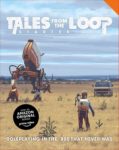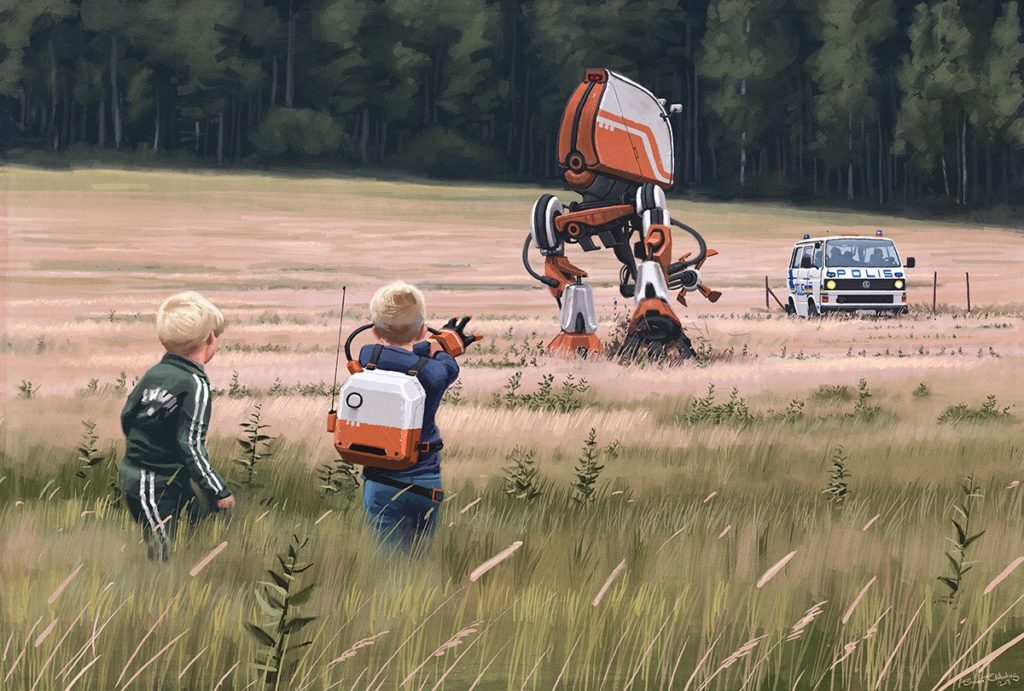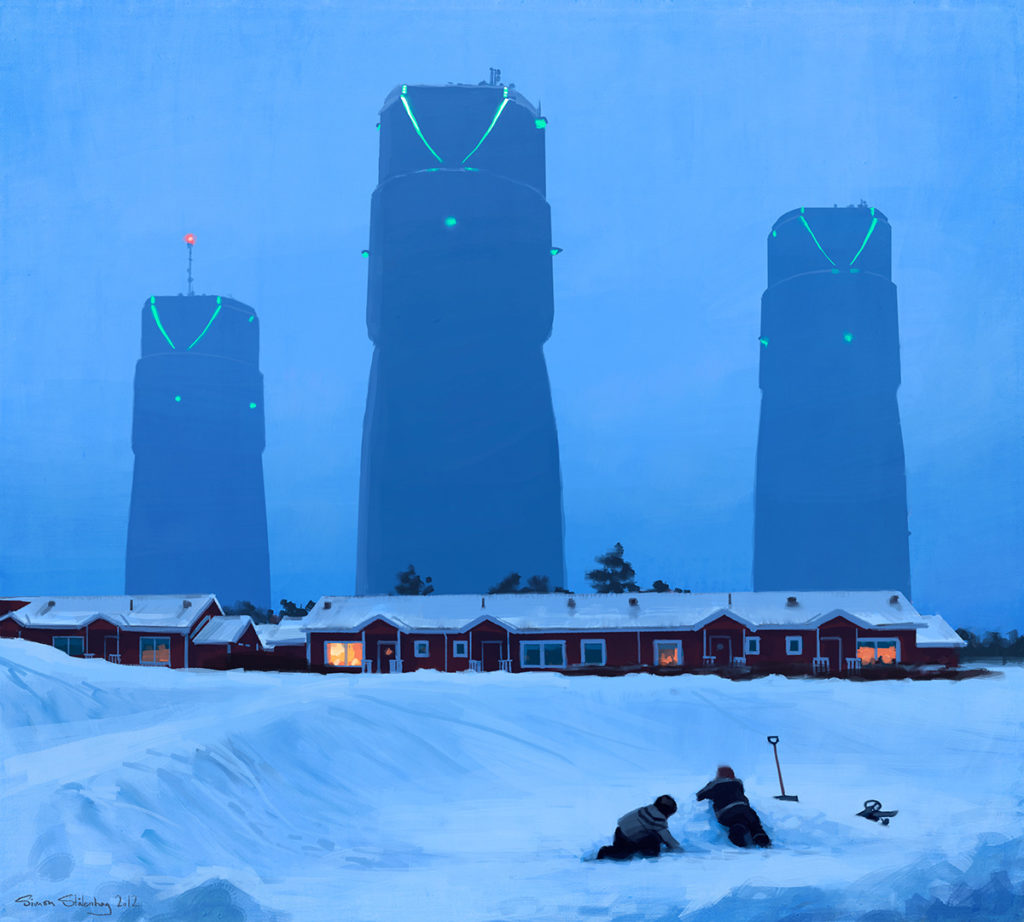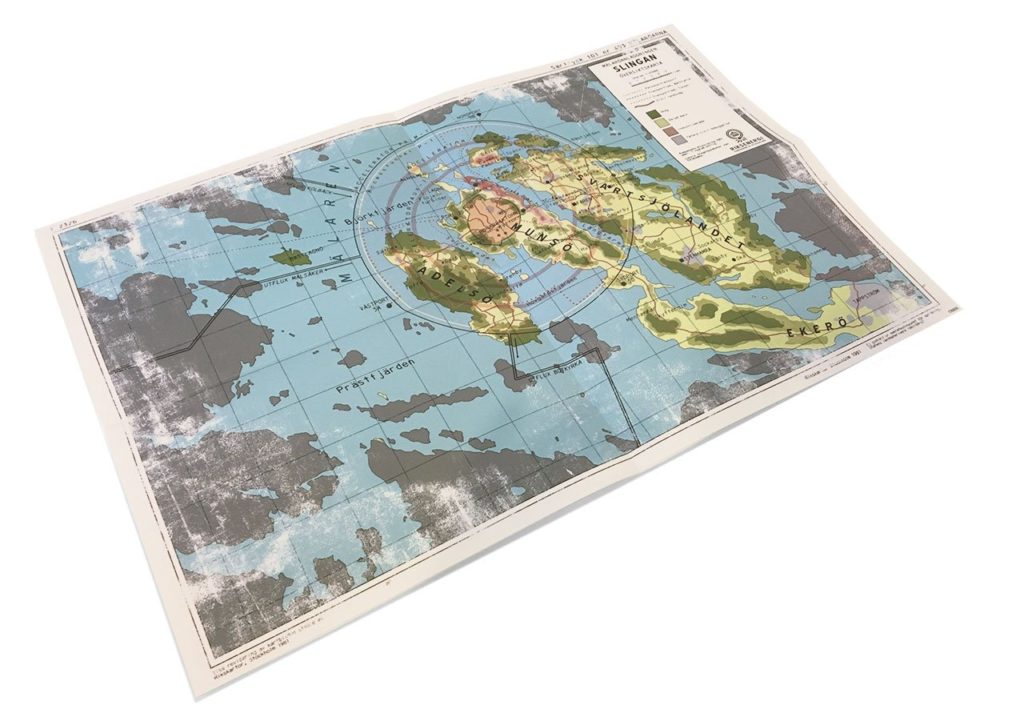Unplugged: Tales from the Loop (RPG)
 Imagine a game set in the 80s where kids on bikes explore their local town. While dealing with every-day problems of parents, bullying, and homework they simultaneously need to sort out strange, otherworldly happenings that somehow just don’t seem to grasp the attention of the adults. One’s first thought may be to think of the Netflix series, Stranger Things but I’m actually referring to the role playing game, Tales from the Loop. The Tales from the Loop role playing game (tagline: Roleplaying in the ‘80s That Never Was) was actually conceived as a stretch goal of a Kickstarter project over a year before the Netflix series ever aired. The Kickstarter project actually set out to compile the hauntingly nostalgic art of Simon Stålenhag of Sweden. His images contrast the everyday life of living in a small town in the 80s, juxtapositioned with what-if images of robots and alien technology. The two art books were easily funded, and a stretch goal was set out (and met) to create a role-playing game based on the art. In a serendipitous moment, the role playing book was released just a few short months after the Stranger Things series and the hype from the Netflix series helped to push the role playing game into the limelight. Jump forward a few years, and publishers have now released a Starter Edition of the game, containing premade characters, the basic rules, dice, and a short playable scenario. Combined with Simon Stålenhag’s surreal art, the box serves as an excellent introduction to the core mechanics and standard backstory for the game. (One final aside, we’ve now come full circle for both Tales from the Loop and Stranger Things. You can watch Tales from the Loop on Amazon Prime and there’s a version of the D&D RPG based on the Stranger Things series on Netflix.)
Imagine a game set in the 80s where kids on bikes explore their local town. While dealing with every-day problems of parents, bullying, and homework they simultaneously need to sort out strange, otherworldly happenings that somehow just don’t seem to grasp the attention of the adults. One’s first thought may be to think of the Netflix series, Stranger Things but I’m actually referring to the role playing game, Tales from the Loop. The Tales from the Loop role playing game (tagline: Roleplaying in the ‘80s That Never Was) was actually conceived as a stretch goal of a Kickstarter project over a year before the Netflix series ever aired. The Kickstarter project actually set out to compile the hauntingly nostalgic art of Simon Stålenhag of Sweden. His images contrast the everyday life of living in a small town in the 80s, juxtapositioned with what-if images of robots and alien technology. The two art books were easily funded, and a stretch goal was set out (and met) to create a role-playing game based on the art. In a serendipitous moment, the role playing book was released just a few short months after the Stranger Things series and the hype from the Netflix series helped to push the role playing game into the limelight. Jump forward a few years, and publishers have now released a Starter Edition of the game, containing premade characters, the basic rules, dice, and a short playable scenario. Combined with Simon Stålenhag’s surreal art, the box serves as an excellent introduction to the core mechanics and standard backstory for the game. (One final aside, we’ve now come full circle for both Tales from the Loop and Stranger Things. You can watch Tales from the Loop on Amazon Prime and there’s a version of the D&D RPG based on the Stranger Things series on Netflix.)
Tales from the Loop (Roleplaying in the ‘80s That Never Was)
Publisher: Free League Publishing
(Review copy provided by Free League Publishing)

While the setting for Simon Stålenhag’s art is a small town in an archipelago in Sweden, the game provides an alternate US-centric option in Boulder City, Nevada. In a slightly jarring manner, locations and names in the game material list one Swedish name first, followed by a bracketed alternate name for those wanting to keep it within a southwestern US theme. The idea is the same for both places. Japan has figured out how to build two-legged walking droids, the US has started researching teleportation, and two giant “Loops” are built (one in Sweden and one in the US) to research high energy physics. It is these two Loops that form the background for the setting. Both are small towns built over the huge underground rings used for research. Most of the people in the town either work or have relatives working in the program. Players take on the roles of kids (aged 10 to 15 years) in the ‘80s and struggle with everyday issues like bullying, the first steps of romance, schoolwork, relationships with parents and teachers, etc… The game has six core principles that form how the stories develop within the game.
- Your hometown is full of fantastic things.
- Everyday life is dull and unforgiving.
- Adults are out of reach and out of touch.
- Mysteries are dangerous but Kids (the player characters) will not die.
- The game is played scene by scene (ie. skipping over the boring bits, like walking around.)
- The world is described collaboratively (ie. both the players and the “game master” work together to create the story narrative.
The mechanics of the game rely on rolling 6-sided dice. A character’s skills and abilities adjust how many dice they roll. Rolling a “6” counts as a success and most rolls only require a single success. Trying to do something particularly difficult might require two or even three. Big, grand finale type interactions will have the players pool together their dice in order to roll enough successes for a total win. Failures affect the storyline but also reduce character effectiveness – with characters becoming Upset, Scared, Exhausted, and/or Injured. Once a character has gained all four effects they are Broken and are unable to roll any more successes until they are patched up.
The game is available in hardcover or PDF form, as well as a few supplements that provide additional pre-made story ideas. There’s even a spin-off Tales from the Flood that places the storyline in a retro ‘90s theme. A recent addition is the Tales from the Flood starter set. It has the basic rules, a short sample adventure, a nice double-sided map (of the two Loops – US & Sweden), pre-made character sheets, and a set of custom dice (they’re normal 6-sided dice but are printed with a game-related theme.)

Verdict:
I think the game here will succeed or fail depending on one’s willingness to embrace 80s nostalgia. In addition to the somewhat haunting art – a juxtaposition of the 80s mundane and fantastic, the game is filled with 80s references. Expect to hear about and encounter LOTS of 80s nostalgia such as movies, songs, and pop culture like mix tapes & VCR players. Playing as a child of the 80s seems to double-down the nostalgia factor. While the game is based around characters of 10-15 years old, I’m not so sure younger kids would buy into the game as described in the setting. Scenes are meant to be played around the core encounters in a story arc, but are also supposed to bring in the more mundane bits of the kids’ lives. I’m not so sure a younger kid really wants to explore parental interactions or roleplay an attempt to get the cute girl in class to notice you. I suppose I could imagine a game more focused on the fantastic side of things, and downplay the more mundane side of things.
As for the Starter Set itself, it runs around $30 while the main handbook is only a few dollars more (at least at online retailers.) You’re not saving any money in order to test drive the game. However, the starter set does come with a very nice 2-sided map as well as the fun set of 10 dice. One nice feature are the streamlined rules and example scenario to quickly give players a feel for how the game is to run. I could see its advantage to newcomers to roleplaying. A more experienced player is probably better off just getting the handbook, even if they only want to give it a try. Of note, the Starter Set and the main handbook are also available for purchase at the online roleplaying site, Roll20.net (Which I highly recommend for social distance gaming.) At $15, the online version of the Starter Set would be a great way to dip one’s toe into the game.

Kid Factor:
Obviously, someone running the game is going to need to be a proficient reader. However, playing a roleplaying game is quite simple even for the younger set. The game, as written, emphasizes both the mundane and the fantastical, and I’m not sure how interesting the more mundane parts would come across to younger players. However, since the characters are kids, a game focused more on the action side of things (and downplaying romance, parental expectations, difficulty with teachers, etc…) may work out quite well.





Discussion Area - Leave a Comment